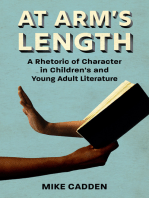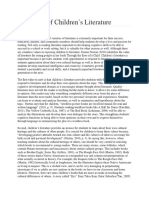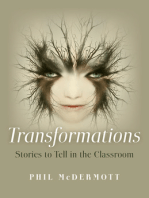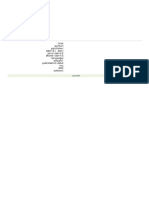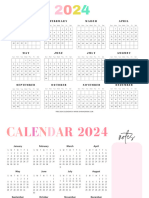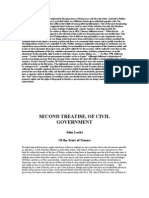Multicultural Text Set
Uploaded by
api-270000798Multicultural Text Set
Uploaded by
api-270000798Multicultural Text Set
Lexi Eaton
ELED: 310
Kroll, V. (1993). Africa Brothers and Sisters (1st ed.). New York: Simon & Schuster Books for
Young Readers.
This book is about a boy, Jesse, and it begins with him wondering why he does not have
any siblings. Jesse asks his father why he doesnt, and his father tells him that he has a lot of
brothers and sisters within the African culture. He then explains all of the people of East Africa
are his brothers and sisters, and the "Turkana" and the "Samburu", or known as the animal
herders are his brothers and sisters, which means he has brothers and sisters everywhere (Kroll).
Jesse and his dad then go into the world of the African brothers and sisters, and they name more
than 21 tribes and places that include Jesses brother and sisters.
This book is more at the upper 3rd grade, and the 4th grade reading levels because of the
vocabulary and the length of the book. This book would be perfect to read during a lesson on the
African culture, because it explains a lot of different groups/tribes within the African Culture. It
also has a lot of vocabulary from the African Culture. This book could be a good way to start a
unit on Africa and to end the unit so the students can see how much they have learned. It also
teaches a lesson about that everyone within your culture is a part of your family.
Multicultural Text Set
Quality Childrens Picture Book Assessment
The following items are provided as a means of assessing the quality of your childrens picture
book. While all books will not address every item, it is important that your book addresses a
number of items in each section.
Title:
Author/Illustrator:
Grade/age:
The story
is interesting to children.
offers children a variety of things to think about, question, or consider.
is age-appropriate and children can understand what is represented.
includes a rich, thick plot.
includes a problem and resolution.
utilizes style and language that are appropriate for the childrens ages and interests.
includes realistic, convincing characters.
The illustrations
are accurate in terms of setting, plot, and characters.
correspond to the text.
hold the childrens interest while the text is read.
enhance and add to the story.
Cultural considerations
Characters represent a variety of cultural groups.
Children are exposed to multiple perspectives and values.
There are no negative stereotypes of the represented groups.
The lifestyles of the characters are genuine and complex not oversimplified or
generalized.
The characters use speech that accurately represents their culture and oral traditions.
The author and/or illustrator are a part of the group represented.
Good characters reflect a variety of backgrounds.
There is diversity represented within cultural groups.
References:
http://www.adl.org/education/assessing.asp
http://ksumail.kennesaw.edu/~pjohnso3/pbkeval.html
http://www.newhorizons.org/strategies/multicultural/higgins/htm
Multicultural Text Set
Gonzalez, M. (2007). My Colors, My World, Mis Colores, Mi Mundo (1st ed.). San Francisco:
Children's Book Press.
This book is about a little girl living in the desert with her family. She explains that even
though the desert does not seem like it has a lot of colors, if you "open [your] eyes extra-wide"
you will be able to see all the beautiful colors around you (Gonzalez, p.6). The little girl then
explains all of the colors she has seen and how pretty they are, especially at sunset. For example,
pink is the color of the sunset and is also her favorite color so she wears it all the time.
This book would be perfect in any grade in an elementary school because it not only
delivers an important message of looking at the world around you, but it also has Spanish
translations on each page next to the English words. Since diversity, especially Spanish native
speakers, are increasing in public schools, this would be a great way to include the students that
speak Spanish. A teacher could have one of her students read the English side, and then have a
Spanish speaking student read the other. This would make them feel very included in the lesson,
and have them be able to show off their knowledge of their own culture and language that they
are not able to do a lot. This would be a great book to read when doing a lesson about the
environment around you in science, or even when learning about recycling because it wants you
to look at the beautiful colors the earth provides you.
Multicultural Text Set
Quality Childrens Picture Book Assessment
The following items are provided as a means of assessing the quality of your childrens picture
book. While all books will not address every item, it is important that your book addresses a
number of items in each section.
Title:
Author/Illustrator:
Grade/age:
The story
is interesting to children.
offers children a variety of things to think about, question, or consider.
is age-appropriate and children can understand what is represented.
includes a rich, thick plot.
includes a problem and resolution.
utilizes style and language that are appropriate for the childrens ages and interests.
includes realistic, convincing characters.
The illustrations
are accurate in terms of setting, plot, and characters.
correspond to the text.
hold the childrens interest while the text is read.
enhance and add to the story.
Cultural considerations
Characters represent a variety of cultural groups.
Children are exposed to multiple perspectives and values.
There are no negative stereotypes of the represented groups.
The lifestyles of the characters are genuine and complex not oversimplified or
generalized.
The characters use speech that accurately represents their culture and oral traditions.
The author and/or illustrator are a part of the group represented.
Good characters reflect a variety of backgrounds.
There is diversity represented within cultural groups.
References:
http://www.adl.org/education/assessing.asp
http://ksumail.kennesaw.edu/~pjohnso3/pbkeval.html
http://www.newhorizons.org/strategies/multicultural/higgins/htm
Multicultural Text Set
Onyefulu, O., & Safarewicz, E. (1994). Chinye, A West African Folk Tale (1st ed.). New York:
Penguin Books USA.
This folk tale follows the storyline of the American's version of Cinderella. Chinye has
lost her parents and lives with her mean step-mother and step-sister. She has to do everything for
them such as cook dinner and clean. One night her step-mother forced her to walk through the
jungle to get some water and she runs into an old lady that tells her that if she passes a hut of
chanting gourds, to always get the smallest and quietest one- it will bring her riches when the
bigger ones bring evil forces. Chinye does what she is told and receives riches. When the stepsister finds out, she tries to do the same thing but goes for the biggest gourd, not listening to the
old lady, and when she does everything vanishes from her and her mothers home which forces
them to leave town. When they leave, Chinye decides to share her wealth with the rest of her
village and they all live happily ever after.
This book is a 3rd grade level reading and would be perfect to read during a lesson on
African culture, and a lesson about how greediness will only result in destruction and to always
be kind to all. Also since it is a spin-off of Cinderella, as a lesson the teacher could read
Disneys version of Cinderella and then read this one and the class could compare the two. After
comparing, they could compare the cultures and learn how every culture is unique in its own
way.
Multicultural Text Set
Quality Childrens Picture Book Assessment
The following items are provided as a means of assessing the quality of your childrens picture
book. While all books will not address every item, it is important that your book addresses a
number of items in each section.
Title:
Author/Illustrator:
Grade/age:
The story
is interesting to children.
offers children a variety of things to think about, question, or consider.
is age-appropriate and children can understand what is represented.
includes a rich, thick plot.
includes a problem and resolution.
utilizes style and language that are appropriate for the childrens ages and interests.
includes realistic, convincing characters.
The illustrations
are accurate in terms of setting, plot, and characters.
correspond to the text.
hold the childrens interest while the text is read.
enhance and add to the story.
Cultural considerations
Characters represent a variety of cultural groups.
Children are exposed to multiple perspectives and values.
There are no negative stereotypes of the represented groups.
The lifestyles of the characters are genuine and complex not oversimplified or
generalized.
The characters use speech that accurately represents their culture and oral traditions.
The author and/or illustrator are a part of the group represented.
Good characters reflect a variety of backgrounds.
There is diversity represented within cultural groups.
References:
http://www.adl.org/education/assessing.asp
http://ksumail.kennesaw.edu/~pjohnso3/pbkeval.html
http://www.newhorizons.org/strategies/multicultural/higgins/htm
Multicultural Text Set
Montes, M. (2000). Juan Bobo Goes to Work (1st ed.). New York: Harper Collins.
Juan Bobo, which means simple John in English, lives in Puerto Rico with his mom. Juan
Bobo is known for being silly and always being confused. Juan's mother, Dona Juana, made him
get a job and wanted him to bring home what he gets every day form work. Juan Bobo, being
confused, had a hard time wondering how to bring home what he has made like money, milk,
cheese, and ham. One day as he is walking home with a tied up ham behind him and all of the
dogs in town were eating the ham and Juan did not know. While walking, Juan passes the house
of the wealthiest family in Puerto Rico. The daughter of the wealthy family is very ill and the
only cure is laughter. She saw Juan walking with the tied ham behind him as well as all of the
dogs following him to eat the ham, and she started laughing and could not stop. Her father heard
the laughter and was so happy that his daughter was cured. As a gift, the father gives Juan Bobo
and his mom a ham every Sunday for dinner.
This book is mostly geared towards a 4th grade reading level due to the vocabulary and
length. This book would be perfect in a classroom that has English and Spanish speakers because
it includes many Spanish words throughout the text. It also would be a great start to a lesson on
the Spanish culture because it introduces a lot of Spanish vocabulary and many cultural aspects.
Multicultural Text Set
Quality Childrens Picture Book Assessment
The following items are provided as a means of assessing the quality of your childrens picture
book. While all books will not address every item, it is important that your book addresses a
number of items in each section.
Title:
Author/Illustrator:
Grade/age:
The story
is interesting to children.
offers children a variety of things to think about, question, or consider.
is age-appropriate and children can understand what is represented.
includes a rich, thick plot.
includes a problem and resolution.
utilizes style and language that are appropriate for the childrens ages and interests.
includes realistic, convincing characters.
The illustrations
are accurate in terms of setting, plot, and characters.
correspond to the text.
hold the childrens interest while the text is read.
enhance and add to the story.
Cultural considerations
Characters represent a variety of cultural groups.
Children are exposed to multiple perspectives and values.
There are no negative stereotypes of the represented groups.
The lifestyles of the characters are genuine and complex not oversimplified or
generalized.
The characters use speech that accurately represents their culture and oral traditions.
The author and/or illustrator are a part of the group represented.
Good characters reflect a variety of backgrounds.
There is diversity represented within cultural groups.
References:
http://www.adl.org/education/assessing.asp
http://ksumail.kennesaw.edu/~pjohnso3/pbkeval.html
http://www.newhorizons.org/strategies/multicultural/higgins/htm
Multicultural Text Set
Doner, K. (2008). On a Road in Africa (1st ed.). Berkeley: Tricycle Press.
This book is about a lady, named Mama O, goes around to different villages of Africa
collecting fruit and vegetables and anything they are willing to donate to her. She describes each
village and all of the wildlife present in each one. Mama O calls attention to the beautiful
wildlife of Africa within each tribe, introducing all of the tribes names and animals that inhibit
each area. At the end of the book, we find out she is collecting for the Nairobi Animal
Orphanage. She and a bunch of volunteers collect anything that can be donated from the tribes
around them and gave it all to the animals that cannot get it themselves.
This book would be for the reading level within 2nd grade because of the vocabulary. This
is a very fun book because it is repetitive, which the children love because they can say the
words along with the teacher, but it is also has rhyming words at the end of every sentence. This
book would be a good book to read in the beginning of a lesson about the animals of Africa
because the book introduces the animals and it also says what each animal eats. It also sets the
setting/climate of which each animal lives in- which is the deserts of Africa.
Multicultural Text Set
10
Quality Childrens Picture Book Assessment
The following items are provided as a means of assessing the quality of your childrens picture
book. While all books will not address every item, it is important that your book addresses a
number of items in each section.
Title:
Author/Illustrator:
Grade/age:
The story
is interesting to children.
offers children a variety of things to think about, question, or consider.
is age-appropriate and children can understand what is represented.
includes a rich, thick plot.
includes a problem and resolution.
utilizes style and language that are appropriate for the childrens ages and interests.
includes realistic, convincing characters.
The illustrations
are accurate in terms of setting, plot, and characters.
correspond to the text.
hold the childrens interest while the text is read.
enhance and add to the story.
Cultural considerations
Characters represent a variety of cultural groups.
Children are exposed to multiple perspectives and values.
There are no negative stereotypes of the represented groups.
The lifestyles of the characters are genuine and complex not oversimplified or
generalized.
The characters use speech that accurately represents their culture and oral traditions.
The author and/or illustrator are a part of the group represented.
Good characters reflect a variety of backgrounds.
There is diversity represented within cultural groups.
References:
http://www.adl.org/education/assessing.asp
http://ksumail.kennesaw.edu/~pjohnso3/pbkeval.html
http://www.newhorizons.org/strategies/multicultural/higgins/htm
You might also like
- Bodies of Inscription - A Cultural History of The Modern Tattoo Community - Margo DeMelloNo ratings yetBodies of Inscription - A Cultural History of The Modern Tattoo Community - Margo DeMello257 pages
- Bumasa at Lumaya: A Sourcebook on Children's Literature in the Philippines: Bumasa at Lumaya, #1From EverandBumasa at Lumaya: A Sourcebook on Children's Literature in the Philippines: Bumasa at Lumaya, #1No ratings yet
- Growing Up in Transit: The Politics of Belonging at an International SchoolFrom EverandGrowing Up in Transit: The Politics of Belonging at an International SchoolNo ratings yet
- Story Play: Building Language and Literacy One Story at a TimeFrom EverandStory Play: Building Language and Literacy One Story at a TimeNo ratings yet
- Bumasa at Lumaya 2: A Sourcebook on Children's Literature in the Philippines: Bumasa at Lumaya, #2From EverandBumasa at Lumaya 2: A Sourcebook on Children's Literature in the Philippines: Bumasa at Lumaya, #23.5/5 (3)
- At Arm’s Length: A Rhetoric of Character in Children’s and Young Adult LiteratureFrom EverandAt Arm’s Length: A Rhetoric of Character in Children’s and Young Adult LiteratureNo ratings yet
- Visual Anthropology in A Discipline of Words Margaret Mead100% (4)Visual Anthropology in A Discipline of Words Margaret Mead8 pages
- Special Method in Primary Reading and Oral Work with StoriesFrom EverandSpecial Method in Primary Reading and Oral Work with StoriesNo ratings yet
- Notable Books For A Global Society ProjectNo ratings yetNotable Books For A Global Society Project20 pages
- The Setting of Children S Literature: History and CultureNo ratings yetThe Setting of Children S Literature: History and Culture25 pages
- ALSCwhitepaper - Importance of Diversity FINAL - 1No ratings yetALSCwhitepaper - Importance of Diversity FINAL - 121 pages
- Opening Doors to a Richer English Curriculum for Ages 10 to 13 (Opening Doors series)From EverandOpening Doors to a Richer English Curriculum for Ages 10 to 13 (Opening Doors series)No ratings yet
- Ready, Set, Read: Building a Love of Letters and Literacy Through Fun Phonics ActivitiesFrom EverandReady, Set, Read: Building a Love of Letters and Literacy Through Fun Phonics Activities4.5/5 (3)
- Building Bridges with Bilingual Books and Multicultural ResourcesFrom EverandBuilding Bridges with Bilingual Books and Multicultural ResourcesNo ratings yet
- The Value of Children's Literature - Oneota Reading Journal - Luther CollegeNo ratings yetThe Value of Children's Literature - Oneota Reading Journal - Luther College7 pages
- Promoting Diversity Through Children's Literature Intro 0No ratings yetPromoting Diversity Through Children's Literature Intro 07 pages
- Better with Books: 500 Diverse Books to Ignite Empathy and Encourage Self-Acceptance in Tweens and TeensFrom EverandBetter with Books: 500 Diverse Books to Ignite Empathy and Encourage Self-Acceptance in Tweens and TeensNo ratings yet
- The Beauty of A Rainbow Takes Shape in Its Separate ColorsNo ratings yetThe Beauty of A Rainbow Takes Shape in Its Separate Colors4 pages
- Cassidiebarnhorsteduc 255 ChildrensbookcritiqueNo ratings yetCassidiebarnhorsteduc 255 Childrensbookcritique17 pages
- Issues: A Resource of Play Scripts and Activities for TeachersFrom EverandIssues: A Resource of Play Scripts and Activities for TeachersNo ratings yet
- The Heart of Homestay: Creating Meaningful Connections When Hosting International StudentsFrom EverandThe Heart of Homestay: Creating Meaningful Connections When Hosting International StudentsNo ratings yet
- Coyote Still Going: Native American Legends and Contemporary StoriesFrom EverandCoyote Still Going: Native American Legends and Contemporary StoriesNo ratings yet
- Wild About Group Time: Simple Literacy Plans for PreschoolFrom EverandWild About Group Time: Simple Literacy Plans for PreschoolNo ratings yet
- Ancient Greece Direct Democracy Lesson PlanNo ratings yetAncient Greece Direct Democracy Lesson Plan3 pages
- Lesson Plan Outline: JMU Elementary Education ProgramNo ratings yetLesson Plan Outline: JMU Elementary Education Program3 pages
- Lesson Plan Outline: Lexi Eaton Mrs. Crawford, 3 Grade-Oak Hill Elementary November 22, 2016 - 9:10amNo ratings yetLesson Plan Outline: Lexi Eaton Mrs. Crawford, 3 Grade-Oak Hill Elementary November 22, 2016 - 9:10am5 pages
- Alan Januszewski-Educational Technology - The Development of A Concept - Libraries Unlimited, Inc. (2001)100% (1)Alan Januszewski-Educational Technology - The Development of A Concept - Libraries Unlimited, Inc. (2001)167 pages
- From Optimizing To Learning: A Development For Systems Thinking For The 1990sNo ratings yetFrom Optimizing To Learning: A Development For Systems Thinking For The 1990s12 pages
- Implementation and Transition ManagementNo ratings yetImplementation and Transition Management6 pages
- Saba Mahmood - Feminist Theory, Embodiment, and The Docile Agent - Some Reflections On The Egyptian Islamic RevivalNo ratings yetSaba Mahmood - Feminist Theory, Embodiment, and The Docile Agent - Some Reflections On The Egyptian Islamic Revival36 pages
- Social Dimensions in Curriculum Development83% (6)Social Dimensions in Curriculum Development8 pages
- Redefining Religious Education Spirituality for Human Flourishing 1st Edition Scherto Gill - Get the ebook instantly with just one clickNo ratings yetRedefining Religious Education Spirituality for Human Flourishing 1st Edition Scherto Gill - Get the ebook instantly with just one click65 pages
- Horizontal 2024 Yearly Calendars by Shining Mom BlogNo ratings yetHorizontal 2024 Yearly Calendars by Shining Mom Blog10 pages
- Understanding Culture Society & Politics 11 LAS 4No ratings yetUnderstanding Culture Society & Politics 11 LAS 411 pages
- 1 - Heritage N Heritage Tourism - 2075.08.27No ratings yet1 - Heritage N Heritage Tourism - 2075.08.2719 pages







